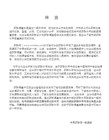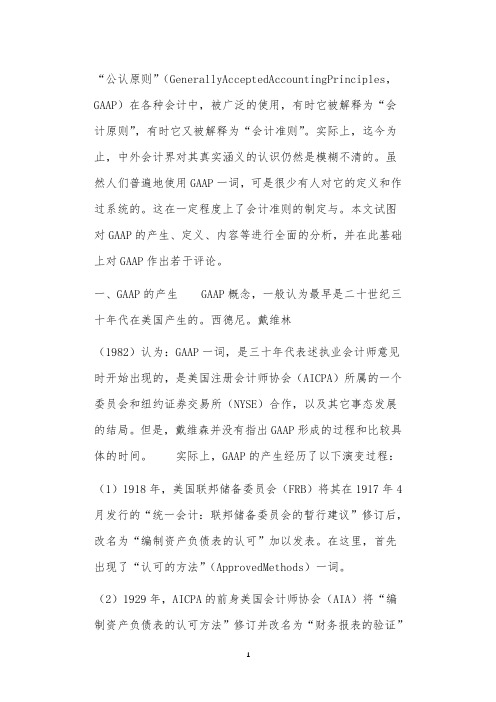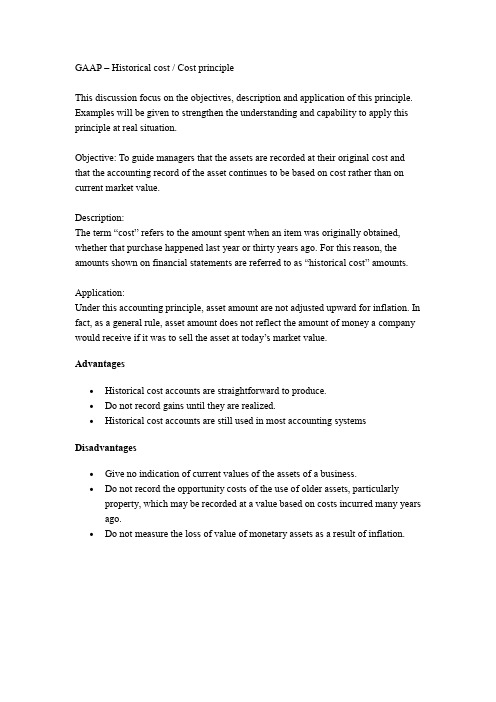GAAP_Periodicity Principle 一般公认会计原则
- 格式:pdf
- 大小:88.78 KB
- 文档页数:3



“公认原则”(GenerallyAcceptedAccountingPrinciples,GAAP)在各种会计中,被广泛的使用,有时它被解释为“会计原则”,有时它又被解释为“会计准则”。
实际上,迄今为止,中外会计界对其真实涵义的认识仍然是模糊不清的。
虽然人们普遍地使用GAAP一词,可是很少有人对它的定义和作过系统的。
这在一定程度上了会计准则的制定与。
本文试图对GAAP的产生、定义、内容等进行全面的分析,并在此基础上对GAAP作出若干评论。
一、GAAP的产生GAAP概念,一般认为最早是二十世纪三十年代在美国产生的。
西德尼。
戴维林(1982)认为:GAAP一词,是三十年代表述执业会计师意见时开始出现的,是美国注册会计师协会(AICPA)所属的一个委员会和纽约证券交易所(NYSE)合作,以及其它事态发展的结局。
但是,戴维森并没有指出GAAP形成的过程和比较具体的时间。
实际上,GAAP的产生经历了以下演变过程:(1)1918年,美国联邦储备委员会(FRB)将其在1917年4月发行的“统一会计:联邦储备委员会的暂行建议”修订后,改名为“编制资产负债表的认可”加以发表。
在这里,首先出现了“认可的方法”(ApprovedMethods)一词。
(2)1929年,AICPA的前身美国会计师协会(AIA)将“编制资产负债表的认可方法”修订并改名为“财务报表的验证”后,再一次交由FRB发表。
1933年,纽约证券交易所要求所有上市公司必须提交附有审计师证明书的财务报表。
而对这些财务报表的审计,则要求遵守“财务报表的验证”并提出关于财务报表是否具有“公允性”、“一致性”以及是否符合“认可的会计实务”(AcceptedAccountingPractices)的意见。
(3)1934年初,在“公司帐目审计”中,AIA推荐了一种审计报告格式,在其意见段的说明中提到了可采用是否遵守“认可的会计原则”(AcceptedAccountingPrinciples)作为衡量财务报表“公允性”的标准。

gaap规则
GAAP(Generally Accepted Accounting Principles,通用会计准则)是指在美国和其他一些国家,公认的会计准则和原则。
这些准则通常用于制定财务报告,以确保其准确、一致和可比。
GAAP规则主要包括以下几个方面:
1. 实体概念:将企业看作一个独立的实体,与其所有者和管理层分开来。
2. 会计基础:包括会计实体、会计期间、会计原则、会计报告等。
3. 资产:包括确定资产的类型、计量方法和折旧、摊销和减值等方面。
4. 负债:包括确定负债的类型、计量方法和利息计算等方面。
5. 所有者权益:包括确定所有者权益的类型、股东利润分配和股东权益变动等方面。
6. 收入和费用:包括确定收入和费用的类型、计量方法和确认时间等方面。
7. 报告:包括编制资产负债表、利润表和现金流量表等方面。
GAAP规则的制定和修订由美国的财务会计准则委员会(FASB)负责,并由美国证券交易委员会(SEC)主管审查。
除此之外,其他国家也有自己的会计准则和原则,如国际会计准则(IFRS)。

GAAP – Matching PrincipleThis discussion focuses on the objective, description and application rules of this principle. Examples have been given to strengthen your understanding.Objective: Guides you how to record "expenditure" (expenses).Description: The amount of “expenses” incurred to generate an amount of “revenue” should be matched to that amount of “revenue” at the period when the “revenue” is earned. This is in regardless when money is received or paid.Application Rules:If payment of $ will bring "future" benefits --> record as "Asset"If payment of $ will bring "current" benefits --> record as "Expense"If payment of $ will bring "NO" benefits --> record as "Loss"Example:Your company paid $100,000 cash for the purchase of a car on 1 September. Your financial year ends by 31 October of the year.Scenario 1: The car is for the delivery of goods to customers.Entries:Dr Car 100kCr Cash 100kNote: “Car” is classified as “non-current asset”Explanation:a) The car in this case fulfills the criteria of a non-current asset, since- you have ownership / control- you have no intention to resale for revenue- it can be measured in monetary value ($100k)- it has economic benefits (for delivery of goods)- you will probably keep it for more than 12 months (owing to its nature)b) Though the car is purchased on 1 September, however, there is no hint showing that you have the intention to "throw" it away in just a few days or weeks.c) According to point b), this car can bring upon "future" benefits, since your company will probably use it for quite a period of time. (e.g. Oct, Nov, Dec etc)d) Consequently, the payment of this $100,000 will bring upon "future" benefits, so we record it as an "asset". In this case, as non-current asset (NCA).e) "Non-current asset" is a permanent ledger, with which the balance will be carried down to the next financial period and the ledger will NOT be closed. It is to be recorded in the Balance Sheet.Scenario 2: (Same example applies but) The car is used as a gift for the lucky draw of a marketing activity for your company.Entries:Dr Marketing Expenses 100kCr Cash 100kNote: “Marketing expenses” is classified as “expense”Explanation:a) The car still fulfills all the criteria of a non-current asset as mentioned in Scenario 1.b) However, under this scenario, the car is purchased only as a "gift" of the lucky draw - which is a marketing activity of your company. The car "will not" and "cannot" be kept after the lucky draw, because it will be given as a gift to the winner (which surely will NOT be your company!).c) According to point b), this car can bring upon "current" benefits ONLY, since your company cannot "use" it for a period of time. (it can be used in the same manner as a "gift" only, e.g. a coupon!)d) Consequently, the payment of this $100,000 will bring upon "current" benefits, so we record it as "expense". In this case, as marketing expenses.e) "Expense" is a temporary ledger, which is to be closed by the end of the financial year and recorded in Income Statement.Final Comment:See the differences? Though the same amount of $ is paid (in this e.g. $100k) and the same item is purchased (in this e.g. the car), however because the duration of benefits that will bring upon by this item (or amount of $) differs (scenario 1 --> long term; scenario 2 --> current), then this same amount of $ will be recorded differently (scenario 1 --> as NCA; scenario 2 --> as expenses).This is exactly what the "matching principle" of the GAAP tells us. It guides us how to record an "amount of expenditure", based on how long the company can benefit from the relative amount of payment.Though this is NOT all!The matching principle also tells us "when" we should record an amount of expenses -- it is when revenue is generated due to this amount of expenses, therefore, comes the "adjustment". In short, matching principle guides us how and when to record expenditure.。

GAAP – Historical cost / Cost principleThis discussion focus on the objectives, description and application of this principle. Examples will be given to strengthen the understanding and capability to apply this principle at real situation.Objective: To guide managers that the assets are recorded at their original cost and that the accounting record of the asset continues to be based on cost rather than on current market value.Description:The term “cost” refers to the amount spent when an item was originally obtained, whether that purchase happened last year or thirty years ago. For this reason, the amounts shown on financial statements are referred to as “historical cost” amounts.Application:Under this accounting principle, asset amount are not adjusted upward for inflation. In fact, as a general rule, asset amount does not reflect the amount of money a company would receive if it was to sell the asset at today’s market value.Advantages∙Historical cost accounts are straightforward to produce.∙Do not record gains until they are realized.∙Historical cost accounts are still used in most accounting systems Disadvantages∙Give no indication of current values of the assets of a business.∙Do not record the opportunity costs of the use of older assets, particularly property, which may be recorded at a value based on costs incurred many years ago.∙Do not measure the loss of value of monetary assets as a result of inflation.Example 1:Top Company purchased land in Year 1 for $300,000 in cash and continues to hold that land, the company's balance sheet in the year Yr 2 will report the land at $300,000 (even the market value of the land at Yr 2 is $500,000).Entry:Purchase of land in Yr 1Dr Land $300,000Cr Cash $300,000Balance sheet in Yr 1:Even the market value of the land is $500,000 in Yr 2, we should still report it as $300,000, the value paid when the land is purchased.Example 2:Fat Company purchased a piece of land for $400,000; some reasonable and necessary costs were included in the calculation of the Acquisition cost of Land. Such as fees paid to the county in $1,500, removal of an unwanted building was $100,000, and leveling was $20,000. What is the balance of Land account?Land $400,000Fees paid to the county 1,500Removal building 100,000Leveling +20,000Acquisition cost $521,500The balance of Land account is $521,500.Why?It’s because they are the costs of bringing the land to its intended use. Assume that Fat Company holds the land for one year, and then offers it for sale at price $1,000,000. The cost principle requires that the accounting value of the land remain at $521,500.Final comment:After discussing the historical cost above; here comes another value in accounting. “Mark-to-market” or “fair value accounting” refers to accounting for the value of an asset or liability based on the current market price of the asset or liability, or for similar assets and liabilities, or based on another objectively assessed "fair" value.Mark-to-market accounting can make values on the balance sheet change frequently, as market conditions change. In contrast, book value, based on the original cost/price of an asset or liability, is more stable. Mark-to-market accounting can become inaccurate if market prices deviate from the "fundamental" values of assets and liabilities because buyers and sellers are unable to collectively and accurately value the future value of income from assets and expenses from liabilities, possibly due to incorrect information or over-optimistic and over-pessimistic expectations.Despite of having several limitations in historical cost accounting, most of the people still believe that historical cost financial statements are more reliable than market value statements. As historical cost accounting is based on actual transactions, the recorded amounts are reliable and verifiable and free from management bias. In addition, under historical cost accounting, there is no scope for manipulation, because the data is supported by sufficient evidences such as: invoices, receipts etc.。
一般公認會計原則(GAAP)壹、財務會計之環境一、會計的意義及基本特質會計的定義:*美國會計學會(AAA):會計是對經濟資訊的認定、衡量、與溝通的程序,以協助資訊使用者做審慎的判斷與決策。
」*美國會計師協會(AICPA):會計係一種服務性之活動,其功能在提供有關經濟個體之數量化資訊…尤其是財務資訊…予使用者,以便使用者藉此資訊在各種行動方案中,做一明智的抉擇。
」*會計可藉由三項基本特性而定義:(1)確認、衡量與溝通,(2)關於經濟個體的財務資訊,(3)給相關使用者以協助其釐定決策。
二、財務報表(financial statement)及財務報導(financial reporting)1.會計的兩大支派----財務會計與管理會計*財務會計之意義:研究如何提供有用資訊以幫助企業外部使用人做決策者,稱為財務會計。
*管理會計之意義:研究如何提供有用資訊以幫助企業內部管理當局做決策者,稱為管理會計。
2.財務報表(含附註揭露)為財務會計之最終產品,用以顯示一企業之財務資訊(會計資訊)。
財務報表包括資產負債表、損益表、現金流量表、業主權益變動表及財務報表附註,附註為財務報表不可分割(integral part)的一部份。
3.財務報表加上補充附表(supplementary schedules)及其他報導方式(如管理當局的討論及分析、財務預測、致股東函、公開說明書)合稱財務報導。
4.財務報表及財務報導之關係財務報導財務報表主要報表+附註+管理當局的討論及分析+財務預測+致股東函+公開說明書三、會計與資本分配1.資本市場分為初級市場與次級市場。
初級市場又稱發行市場,係指公司原始向社會大眾投資人發行股票、債券或其他權益憑證,亦即原始發行證券的市場。
次級市場又稱交易市場,為以發行證券之交易市場,如證券交易所及證券櫃檯買賣中心等,方便已發行證券之流通轉讓。
初級市場(發行市場) 股票資本市場投資人次級市場(交易市場) 公司債公司向外吸收資金貸款金融市場發行票券債權人賒帳2.資本分配過程四、財務會計所面臨之問題及挑戰1.挑戰(1)非財務指標(2)預期資訊(3)軟體資產(4)時效性2.為克服上述之挑戰,美國會計師協會特殊問題委員會建議未來財務報表應包括下列資訊:(1)財務資料與非財務資料*財務報表與其相關策路。
GAAP_RevenueRecognitionPrinciple一般公认会计原则GAAP – Revenue Recognition PrincipleThis discussion focuses on the objectives, description and application of this principle. Examples will be given to strengthen the understanding and capability to apply this principle at real situation.Objective:To set forth the criteria for recognizing and recording revenue in the accounting period.Description:According to the revenue recognition principle, revenue must be reported when it is realized and earned, not necessarily when the actual cash is received. In addition, the following four criteria or conditions must also be met for revenue to be recognized:1. Delivery has occurred or services have been rendered2. Persuasive evidence of an arrangement for customer payment exists3. Price is fixed or determinable4. Collection is reasonably assuredApplication:Revenue is an item that investors and analysts always pay attention to. In order to avoid misrepresentation (overstatement and understatement) of revenue, GAAP has provided additional guidance for revenue reporting for different situations.For the traditional retail business, goods are delivered to the customers at the same time cash is received, and revenue will be recognized at the time of sales. However in other case that cash could be collected before or after goods or services are delivered,the timing of cash receipts from customers does not dictate when businesses report revenues.Instead, revenue will usually be recognized when the title, risks, and rewards of ownership have transferred to the customers. Depending on the situations, revenue may be recognized at different point of time.Example #1 (cash received at the same period goods/services delivered):The newspaper stand sells Macao Daily News to a customer who pays $4 cash and takes away the newspaper immediately.Entries:Dr. Cash…………… $4Cr. Revenue…………..$4Since cash is received at the same time the newspaper is delivered and all the four criteria are met, revenue will be recognized right away:Example #2 (cash received before goods/services delivered): On Jan 1, the Fortune Magazine has received a subscription form and $120 from an IFT student for subscribing 12 issues of Fortune Magazine ($10/issue). The student will receive 1 issue of the magazine on the last day of each month for 12 consecutive months. Entries:Jan 1 (cash received):Dr. Cash………………$120Cr. Unearned revenue …..... $120Jan 31 (and last day of every month):Dr. Un earned revenue… $10Cr. Revenue ………………..$10When the company received the $120 annual subscription fee for the magazine, criteria #1 has not been met and revenuecould not be recognized at that point of time. The cash received represented obligations to provide future magazine issues to the students which will be booked to the “Unearned Revenue” account temporarily.By definition, “Unearned Revenue” is the collection of cash from customers or clients before goods or services are delivered. Since the goods or services have not been delivered yet, the revenue cannot be considered as “earned”, these cash receipts are considered future obligations to the customers and will be booked to “Unearned Revenue” as a liability account. Only when the goods or services are partial ly or fully delivered, the n the related amount will be unwound from the “Unearned Revenue” account and finally be recognized as “Revenue” earned.In the above example, by the end of each month when the company deliveries the magazine to the student, it earns and records the revenue and reduces the liability account or “Unearned Revenue” account balance.Example #3 (cash received after goods/services delivered): An old customer filled in the cleaning form and dropped off his jacket for cleaning at Dave’s Dry Cleaning on June 30, listed price for cleaning such jacket is $30. Dave cleans the jacket on July 1, but customers do not claim and pay for the jacket until August 1. Entries:June 30 (Customer requests service):No Journal EntryJuly 1 (Service performed):Dr. Accounts Receivable …$30Cr. Revenue……………………..$30August 1 (Cash Received):Dr. Cash………………… $30Cr. Accounts Receivable ….…$30Under the revenue recognition principle, Dave’s earns revenue on July 1, rather than August 1 when cash is received, since it performed the service and met all the four criteria for revenue recognition. On July 1, Dave’s would report a receivable on its balance sheet and revenue in its income statement for the service performed.Final Comment:The following chart summarized the revenue recognition timing for different scenarios as illustrated in the above examples.SCENARIOS 1:Cash received same period goods/services are delivered --> Eg. Sale of product for cash --> Revenue Recognition at date of sale (date of delivery)SCENARIOS 2:Cash received before goods/services are delivered --> Eg. Revenue from subscriptions --> Revenue Recognition as time passes or upon consumptionsSCENARIOS 3:Cash received after goods/services are delivered --> Eg. Sale of service on credit --> Revenue Recognition when services performed and billable。
美国公认会计原则(US GAAP)与国际会计准则(IFRS)之间存在的主要差异1.在存货成本的计算方法上, IFRS规定禁止使用后进先出法。
US GAAP规定可以采用后进先出法。
2.在存货减值的转回上,IFRS规定在满足一定的条件时﹐需予以转回。
US GAAP规定不可以转回。
3.在现金流量表中收取和支付利息的分类上,IFRS规定可包括在来自经营活动、投资活动或筹资活动的现金流量中。
US GAAP规定必须归类为经营活动。
4.在完工比例无法确定的建造合同上,IFRS规定成本收回法。
US GAAP规定合同完工法。
5.在报告分部的基础上,IFRS规定根据业务和地区划分。
US GAAP规定根据公司内部向高层管理人员报告的信息组成进行划分﹐可以是也可以不是根据业务和地区划分。
6.在广场、厂房及设备的计量基础上,IFRS规定可以使用重估价或历史成本。
如果是按重估价计量﹐会根据重估日的公允价值减之后的累计折旧和减值损失列示。
US GAAP规定通常要求使用历史成本。
7.在辞退福利上,IFRS规定没有区分开“特别”和其他辞退福利﹐在雇主表明承诺会支付时确认辞退福利。
US GAAP规定当雇员接受了雇主提供的条件且金额能够合理估计时﹐确认“特别”(一次性)辞退福利;当雇员很可能有权享有﹐且金额能够合理估计时﹐确认合约性辞退福利。
8.在确认与既定福利相关的过去服务的成本上,IFRS规定立即确认。
US GAAP规定在剩余服务年限或生命期间摊销。
9.在设定受益计划中﹐最小应确认的负债金额上,IFRS规定没有最小的要求。
US GAAP规定应确认的负债金额最小为未注资的累积福利义务。
10.在养老金资产确认上的限制上,IFRS规定确认的养老金资产不能超过未确认的过去服务成本、精算损失以及从该计划返还资金或减少对计划的未来提存金供款而得到的经济利益的现值之总净额。
US GAAP规定对确认的金额没有这样的限制。
11.在确认缩减利得的时间上,IFRS规定当有关企业有明确表示将福利计划缩减﹐且已经对外宣布时﹐确认缩减利得和损失。
cpa审计法规CPA审计法规是指针对注册会计师(Certified Public Accountant,简称CPA)在进行审计工作时需要遵守的法律、法规、准则和规范。
这些法规旨在确保审计人员在执行其职责时具有适当的道德和专业行为,并确保其所提供的审计报告具有公正、准确和可靠的特点。
在美国,CPA审计法规主要包括以下几个核心文件:1. 美国公认会计准则(Generally Accepted Accounting Principles,简称GAAP):GAAP是美国会计界广泛接受的一套会计原则和规范,规定了会计信息的编制和披露要求。
审计人员需要遵循GAAP的要求进行审计工作,以确保财务报表的准确性和可比性。
2. 美国公认审计准则(Generally Accepted Auditing Standards,简称GAAS):GAAS是美国审计行业广泛接受的一套审计准则,规定了审计人员在执行审计工作时应遵循的程序和方法。
GAAS 要求审计人员具有独立性、专业判断力和技术能力,并对审计工作的执行过程进行规范。
3. 美国证券交易委员会(Securities and Exchange Commission,简称SEC)规定:SEC是美国联邦政府的机构,负责监管证券市场和保护投资者利益。
CPA在进行证券交易所上市公司的审计时,需要遵守SEC的相关规定,包括审计报告的披露要求和其他相关审核要求。
此外,不同州的会计师协会和注册会计师考试委员会也可能制定一些具体的审计法规和规范,以适应当地的法律和市场环境。
CPA需要遵守这些地方性的法规和规范,以保证其在当地执业的合法性和合规性。
总之,CPA审计法规是CPA在执行审计工作时需要遵守的一系列法律、准则和规范,旨在确保其具有独立性、专业性和道德操守,以提供公正、准确和可靠的审计服务。
GAAP – Periodicity PrincipleThis discussion focuses on the objectives, description and application of this principle. Examples will be given to strengthen the understanding and capability to apply this principle at real situation.Objective:To divide the economic life of a business into shorter artificial time periods in order to assess and compare the financial conditions and results of operations for specific periods of time.Description:Business keeps operating continuously, but investors and financial information user could not wait until the closure of the business to obtain the bottom line or financial positions of the company. As such, the periodicity principle requires financial information to be reported in artificial period intervals, such as 12-months, quarters and months. Application:Some business, especially the service sector, by nature keeps running continuously 24 hours a day, 7 days a week nonstop. For example, a hotel will host guests overnight and the water/electricity bills keep running at the same time. These processes and activities will continue until the hotel cease operations.For investor and management, they could not wait that long to obtain financial information for their decision making. In order to provide timely information, it is necessary to “draw a timeline” for reporting. Usually this timeline is drawn for the intervals of months, quarters or year to enhance comparability across industries and within the organization for different period.When we draw such timeline, it does not necessary mean that all operations have to stop at that point of time. For example, if a hotel is reporting their financial information at the end of the month, they could not ask the guest to leave the hotel by the midnight of the last day of month, and they could not cut off the electricity and water from running.As such, in order to appropriately allocate all revenue and expenses to the time periods, we need to go through a process of “estimation” or “accrual basis”. When the “estimation”or “accrual” process is consistently applied every month, we could ensure the financial reporting for each time period intervals is accurate and comparable for use to measure the performance of the company.Example:You are operating a car rental company, a hotel has agreed to rent your cars for the whole year for $240,000 and payment will be made every quarter. The other expenses you incurred included salaries ($8,000/mth), office rental ($60,000/yr), electricity & water (utilities depend on consumptions), maintenance (depends on consumptions) and depreciation ($60,000/yr).To comply with the “periodicity” principle and to meet your owner’s requirement, the car rental company is required to produce monthly financial reports.Entries at end of each month:For Revenue:Dr. Accounts Receivable….. $20,000Cr. Revenue……………………..$20,000**($240,000 / 12 months)For Expenses:Dr. Salaries expense …………$8,000Cr. Accounts payable …………. $8,000Dr. Office Rental expense……$5,000*Cr. Prepare rent …………. $5,000*($60,000/12 months)Dr. Utilities expense…………$XXX (depends on actual consumptions) Cr. Accounts payable …………$XXXDr. Maintenance expense……$XXX (depends on actual consumptions) Cr. Accounts payable …………$XXXDr. Depreciation exp ense……$5,000Cr. Accumulated depreciation….$5,000**($60,000/12 months)To comply with the monthly reporting requirement in accordance to the periodicity principle, we have calculated the revenue and expenses of the company for the month. After we put in the above entries for both revenue and expenses, we will be able to get an idea on the performance of the company for that particular month (if the company is making profit or loss). After we have the data for couple months, the management could investigate the fluctuations and look into means for improvements.Final Comment:As a final note, most of the annual financial reporting will coincide with the “Calendar Year”, i.e. from January 1st to December 31st. However, in some industry such as airline & hotel, December is the peak season and the company could not spare resources to wrap up the financial reports by December 31st. In this case, the company choose to adopt “Fiscal Year” instead, that is reporting for 12 consecutive months starting from any da y other than Jan 1st. For example, most airlines adopt for the fiscal year reporting from April 1st to March 31st of the next year.It should also be noted that some government may impose restrictions on the financial statement report period for the companies who register in their country or region. For example, Hong Kong government requires all Hong Kong companies to adopt March31st as year-end for all government and tax filings, while Macau government requires Dec 31st as year-end for Macau companies. Companies need to observe and take into considerations these government restrictions when they choose the “fiscal year” for their financial statement reporting.。